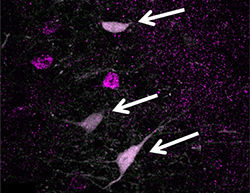Interneuron plasticity ensuring long-term memory formation
Advertisement
Understanding learning and memory processes is of fundamental importance to the study of brain function and provides valuable insights for disorders where these processes are disturbed. The current study of Pico Caroni from the Friedrich Miescher Institute for Biomedical Research, identifies plasticity induced at the time of learning, which is necessary during 12-14 hours after acquisition for long-term memory formation. It shows how learning-induced changes in parvalbumin basket cells are sustained by dopamine signaling for several hours and how basket cell plasticity 12 hours after the learning experience is required for enhanced network activity and long-term memory formation.

Dopamine D1/5 receptor signaling in parvalbumin (PV) basket interneurons of hippocampal CA1 in vivo. White: PV; magenta: pERK; arrows: PV+/pERK+ neurons.
Pico Caroni/FMI
Several pieces of the long-term memory formation puzzle have been known, some for a while: the brain area called the hippocampus plays a role; the neurotransmitter dopamine is crucial; a time window 12 hours after learning is important; ripples – oscillations of large neuronal networks between different brain regions – help consolidate a memory; and recently Pico Caroni and his research group at the FMI showed that the plasticity of local so called parvalbumin basket cells modulates learning and memory. However, how these pieces fit together and lead to long-term memory had remained elusive.
In a study, Pico Caroni – a Group leader at the FMI and Professor at the University of Basel – and the two first authors Smitha Karunkaran and Ananya Chowdhury beautifully dissected the interplay of these molecules, cells, neuronal networks, time points and phenomena in long-term memory formation and gained interesting new insights.
Upon learning, the state of the network of parvalbumin basket cells within brain areas involved in the particular type of learning changes, new connections are formed, protein levels in the basket cells change, and the response to neuronal signals alters. These modifications, which are summarized in the term “plasticity”, are paramount – as the scientists now show – for long-term memory formation.
The FMI scientists found that dopamine, through the D1/5 dopamine receptor on basket cells, helps maintain the changes induced in basket cells during learning. Interestingly, this is particularly important 12-14 hours after the learning experience, when enhanced network activity is thought to consolidate circuitry changes that encode long-term memories. Without the dopamine signal after 12 hours, basket cell plasticity is rapidly lost and no long-term memory is formed. “This time window at 12-14 hours is independent of the day-night cycle, and specifically associated to each memory. It is as if each new learning process starts a clock that will ultimately result in consolidation of memories 12-14 hours later. So, why 12-14 hours? We do not know,” commented Caroni. “It might be that the processes occurring between acquisition and this critical 12-14 hours time window ensure that what is learned is validated through subsequent experience, and that what is consolidated into long-term memory is also compared and integrated with previous learning.”
The scientists showed that parvalbumin basket cell plasticity 12-14 hours after learning is required to ensure enhanced network ripple activity and memory cell plasticity required for long-term memories. Caroni explains: “In our study we have been able to attribute specific roles in long term memory formation to previously identified players and events. And the parvalbumin basket cells are in the middle of it all.”























































